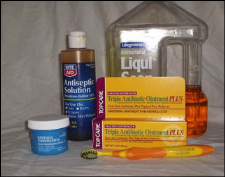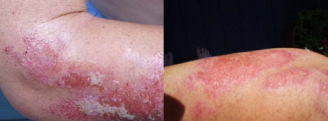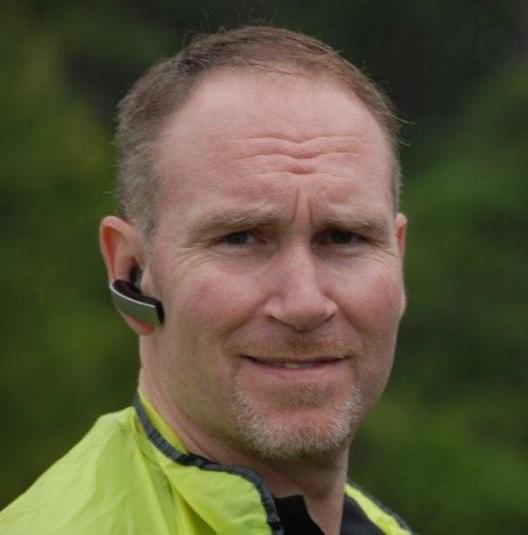How to Care for Road Rash
Injuries, November 30, 2014
by: Peter Cummings. Note - As with all medical issues the best advice is to be seen by medical professionals.
Skin abrasions from asphalt, better know to cyclists as Road Rash, can be very serious if not taken care of promptly and properly. When treated properly, Road Rash can heal very fast, cutting very little into your training. This article will help you in the care for these injuries.
First, you will need to learn to identify the different degrees of Road Rash. This plays a big role in determining the proper treatment. There are 3 degrees of Road Rash, which are actually very similar to burns. The first-degree is a burn that causes only superficial redness to the skin. These would be similar to the type of burn a child might get from sliding on a rug. This first-degree really doesn’t require active treatment. Second-degree road rash is what this article will be focused on since third-degree road rash may require grafting to heal properly and immediate medical treatment in vital for third-degree wounds. Third-degree can be identified by supportive tissue being exposed or the complete removal of the skin. In Second-degree wounds, the skin is broken, there is blood but the deep layer remains which will allow the skin to replace and heal itself. If you aren’t sure of the degree of the wound medical consults are always recommended. Unfortunately, I do not have any good “before treatment” picture of 2nd degree wounds to show you.
The objective of treatment is to help the wound heal as quickly, safely and as effectively as possible. The method I recommend and about to describe is referred to as the “Closed Approach”. The other method, know as the Open Method, has its draw backs. The Open Method involves cleaning the wound once and letting it dry out and scab. Scabs often crack and become infected and can scar if opened repeatedly. This proves to be problematic. Before I describe the Closed Approach, let’s discuss what you will need to treat the injury. Below is a picture of the supplies you will need. As mentioned in my newsletter (head to Plan2Peak.com to sign up for your copy), I recommend traveling with these items. With all the out of town racing we do shopping for these supplies after the incident in a strange town can be difficult. How to Care for Road Rash by: Peter Cummings
Pictured is an antiseptic solution, such as Betadine, anti-bacterial liquid soap, triple anti- biotic ointment, such as Neosporin, a baby, soft bristle tooth brush, and Silvadene or Thermazene (this is also anti-biotic cream you can get only from a doctor). Two other items that are not pictured are non-stick or Vaseline gauze pads and surgical netting or Tubigauze. You can get stretch netting in medical supply stores.

Treatment in the “Closed Approach” begins with cleaning the wound, this process of cleaning is repeated throughout the process. Keeping the wound clean is a critical step to insure one of the most important goals which is the preventing of infection. Start with the liquid soap and warm water, and then move onto the Betadine. Completely cover the wound with the Betadine and use the tooth brush to remove any dirt, stones or other debris left in the wound. Try to avoid further injury to the tissue BUT you are not done cleaning the wound until all debris is removed. I find it very helpful to find a strong willed friend to help do this step the first time or two while you bite on a towel. It helps with the pain.
Once the wound has been thoroughly cleaned, it is time to cover it. Coat a gauze pad with the Neosporin and Silvadene and lay this pad on the wound. Use the Tubigauze to hold this compress in place. The Tubigauze is MUCH better than tape. Tape will stick to your skin and is problematic removing.
I like to air it out often, like when not in public, but you must keep it covered and very moist with Neosporin and/or other anti-biotic ointments. You don’t want a scab to form or the wound to dry. In fact, every day, twice a day, you need to redo the cleaning process to remove any scab that begins to form and to re-clean and re-dress the wound. A great way to start this twice daily routine is with a long shower or warm bath to soften any drying scabs. I know this sounds rough but after a few days you will see the scabbing process will stop and the pink fresh skin will be forming. Below are pictures of before daily cleaning and after cleaning, before re-dressing. Note- after this for the first few days it will still bleed. This is not a problem. Each day it will bleed less and less until only pink skin remains.

On the Left, a picture before cleaning, you can see the whitish, moist scab forming. On the right (just 72 hours later) is the wound after cleaning with the semi-formed scab removed and nothing but the fresh, new pink skin forming. After cleaning, re-apply the ointments and gauze continuing this process until the skins pinkness starts to disappear.
After the wound is nothing but pink skin, keep the wound covered with both an anti- biotic cream and SUNSCREEN. A wound like this left unprotected in the sun will darken and scar. Note – if you are allergic to Sulfur drugs avoid using Silvadene/Thermazene and replace this product with Mupirocin. While Mupirocin is more expensive it is safe for those with allergies to sulfur drugs. Remember, you must continue to cover and protect this wound from the sun for quite some time.
Follow these procedures and your road rash will be as little of an issue as possible. If you decide not to follow these guidelines cracking of scabs, continual bleeding and scarring is likely. The guidelines I have outlined in this article come directly from an International Olympic Committee’s medical commission publication that was sanctioned by the UCI. Unfortunately, I have used them on myself and many of my athletes but fortunately for us the procedure worked beautifully.
 Peter Cummings specializes with training with Power meters and the use of the TrainingPeaks platform and WKO+. He was certified by the American College of Sports Medicine in 1993. He is a Certified and Licensed USA Cycling Level II (Expert) Coach with Distinction, and Certified USA Cycling Skills Instructor. He serves as the Director of Medical Fitness and Cardiac Rehabilitation at a facility in Williamsville. As a health club owner and coach he has directed and overseen the programming of over 10,000 individual and has been racing bicycles since 1991. His many athletes stand on podiums at Nationals, State and Local championships and have worn the Stars and Stripes National Championship Jersey. He is available for consultations, presentations, testing, programming or coaching. Those interested can contact him at Peter@Plan2Peak.com. For more articles on training and racing with power and other cycling specific topics by Coach Cummings visit www.Plan2Peak.com.
Peter Cummings specializes with training with Power meters and the use of the TrainingPeaks platform and WKO+. He was certified by the American College of Sports Medicine in 1993. He is a Certified and Licensed USA Cycling Level II (Expert) Coach with Distinction, and Certified USA Cycling Skills Instructor. He serves as the Director of Medical Fitness and Cardiac Rehabilitation at a facility in Williamsville. As a health club owner and coach he has directed and overseen the programming of over 10,000 individual and has been racing bicycles since 1991. His many athletes stand on podiums at Nationals, State and Local championships and have worn the Stars and Stripes National Championship Jersey. He is available for consultations, presentations, testing, programming or coaching. Those interested can contact him at Peter@Plan2Peak.com. For more articles on training and racing with power and other cycling specific topics by Coach Cummings visit www.Plan2Peak.com.